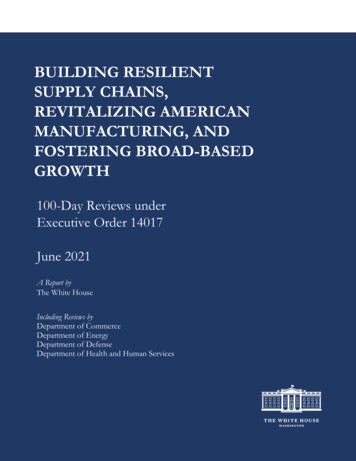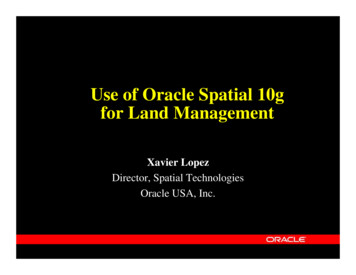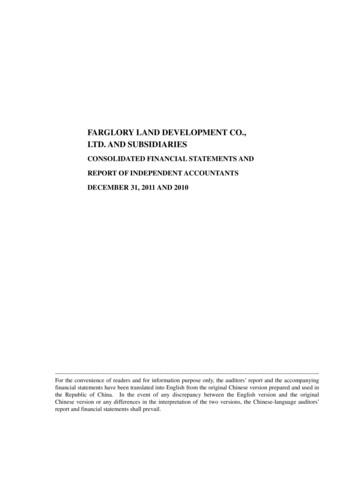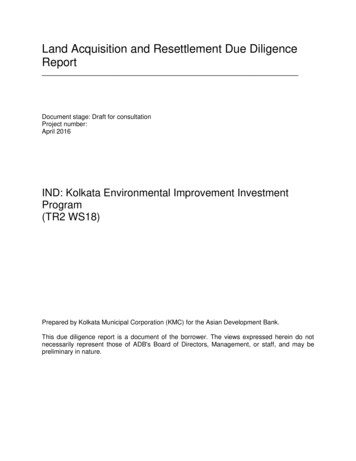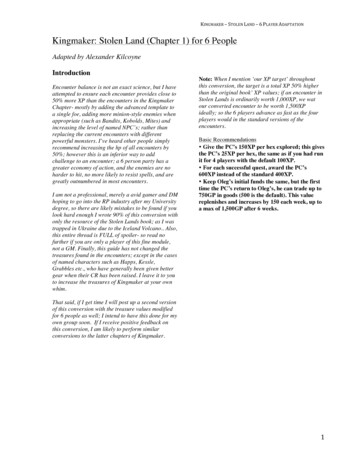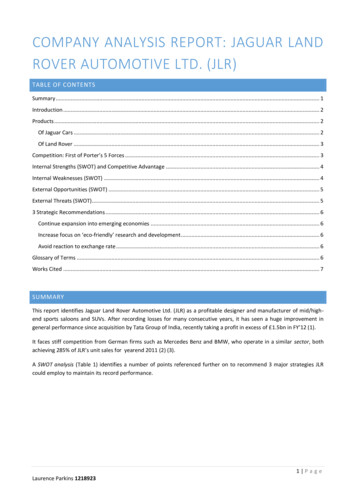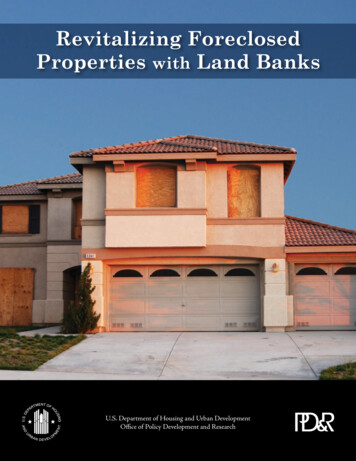
Transcription
Revitalizing ForeclosedProperties with Land BanksU.S. Department of Housing and Urban DevelopmentOffice of Policy Development and Research1
Visit PD&R’s website www.huduser.org to find this report and others sponsored by HUD’s Office of PolicyDevelopment and Research (PD&R). Other services of HUD USER, PD&R’s Research Information Service,include listservs; special interest reports, bimonthly publications (best practices, significant studies from othersources); access to public use databases; and hotline 1-800-245-2691 for help accessing the information you need.
Revitalizing ForeclosedProperties with Land BanksPrepared for:U.S. Department of Housing and Urban DevelopmentOffice of Policy Development and ResearchPrepared by:Sage Computing, Inc.Reston, VAAugust 2009
The contents of this report are the views of the contractor and do not necessarily reflect the views orpolicies of the U.S. Department of Housing and Urban Development or the U.S. Government.
Table of ContentsIntroduction.1What Are Land Banks? . 1History. 2What Do Land Banks Do?.2Benefits of Land Banks.3Emerging Trends.4Land Bank Challenges. 6Getting Started.6Appendix A — Genesee County Land Bank Authority. 9Appendix B — Baltimore City, Maryland. 12Appendix C — The Fulton County/City of Atlanta Land Bank Authority. 16Endnotes.19List of FiguresFigure 1: Land Bank Functions.4Figure 2: Timeline for Mortgage Foreclosures.6Figure A1: Percentage of Total Vacant Housing Unitsin the city of Flint and Genesee County, Michigan.9Figure B1: Baltimore City, Maryland’s Project 5000 Results.13Figure C1: Fulton County/City of Atlanta Land Bank AuthorityTransfer of Property Process.18iii
INTRODUCTIONForeclosures are at the forefront of issues affecting today’s housing market. The volume offoreclosures has become a significant problem, not only to local economies, but also to theaesthetics of neighborhoods and property values therein. At the same time, middle- to lowincome families continue to be priced out of the housing market while suitable housing units remainvacant. In 2008, the mortgage foreclosure crisis gripping the nation added over 1.2 million foreclosedhomes, increasing the inventory of vacant housing units.1 According to the U.S. Census Bureau, therewere over 14 million vacant units (year-round housing units intended for occupancy at any time ofthe year) in the nation during the first quarter of 2009, up from 12.6 million units in 2006.2When properties remain vacant for prolonged periods, they can fall into disrepair,become neglected, and eventually be abandoned by their owners. Abandonedproperties pose significant fire and safety hazards, attractvandalism, and generate criminal activity.3 These properties createa ripple effect, lowering adjacent property values and contributingto the decline of entire neighborhoods. A 2005 report preparedfor the Homeownership Preservation Foundation notes that asingle foreclosed unit in a Chicago neighborhood reduced theproperty values of 13 homes located within 150 feet.4 In addition,communities with a large number of tax-delinquent properties loseconsiderable revenue and further burden local governments withincreased maintenance and service costs. For instance, according toa National Vacant Properties Campaign report, Detroit, Michiganspends 800,000 a year on vacant lot cleanup alone.5While it’s in a community’s best interests to promote theredevelopment of abandoned and tax-delinquent properties, thereare a number of barriers that inhibit progress, such as complicatedstate tax foreclosure processes and a lack of local governmentmechanisms to regain control of such properties. Some states allowtax liens to be sold at auctions, where buyers (usually speculators)have no immediate interest in returning the property to reuse. Inother instances, properties that remain unsold at auctions becomegovernment-owned through a lengthy foreclosure process, duringwhich time they decline in value and potential use.To ameliorate the negative effects of foreclosures, some communities are creating public entities — known as land banks — toreturn these properties to productive reuse while simultaneouslyaddressing the need for affordable housing. This report examinesthe concept of land banking and discusses barriers and solutionsA dilapidated doorway in Baltimore, Maryland.to the successful implementation of land banks. The report alsocontains case studies from three local jurisdictions — GeneseeCounty, Michigan; Atlanta, Georgia; and, Baltimore, Maryland— that detail their experiences in land banking.WHAT ARE LAND BANKS?Land banks are governmental or nonprofit entities that acquire, hold, and manageforeclosed or abandoned properties. Enabled by state legislation and enacted by localordinances, these legal entities are typically governed by a board of directors that1
“A home is abandoned whenmortgage or tax foreclosureproceedings have been initiated forthat property, no mortgageor tax payments have been madeby the property owner for at least90 days, AND the property hasbeen vacant for at least 90 days.”9— The Neighborhood StabilizationProgram definition of anabandoned home.adhere to bylaws and articles of incorporation specifically tailored to meet the needsof individual communities. Funded with local government allocations or revenuefrom operations, they can be staffed by independent, full-time employees or by localgovernment employees on a part-time basis.HISTORYContemporary urban land banks were created in response to a large number of taxdelinquent properties and widespread property abandonment in cities experiencinga loss of industrial jobs.6 One such land bank was established in St. Louis, Missouriin 1971 to acquire tax-foreclosed properties that remained unsold at sheriff sales.7Operations under the St. Louis Land Reutilization Authority include acceptanceof donated property, assembly, and consequent maintenance of land to facilitatefuture development. Five years later, the state of Ohio adopted land bank-enablinglegislation.8 Following passage of the legislation, the city of Cleveland established aland bank to acquire and dispose of tax-delinquent properties. Ohio subsequentlyadopted legislation in 1988 that further strengthened the land bank statute byexpediting the tax foreclosure process and allowing tax abatements on land bankproperty.In 2003, the state of Michigan adopted one of the most progressive land bankinglegislations in the nation (further discussed in Appendix A). In addition to grantingcity and county land bank authorities the power to assemble, sell, or redeveloplarge numbers of abandoned properties, Michigan’s legislation allows land bankauthorities to utilize tax-increment financing for the redevelopment of vacant andabandoned properties.10 Other states that have adopted land bank legislation includeGeorgia, Indiana, Texas, Kentucky, and Maryland.What Do Land Banks Do?Land banks acquire properties through tax foreclosure,intergovernmental transfers, nonprofit transfers, and openmarket purchases. Tax foreclosures are the most commonmethod of acquisition. They allow state or local taxingauthorities to recoup delinquent back taxes by imposing alien on a property without the owner’s consent. Pursuantto state foreclosure laws, these properties are then sold at apublic auction; those properties remaining unsold are deededto land banks. While land banks have historically functionedto acquire tax foreclosures, the passage of the Housing andEconomic Recovery Act (HERA) in 2008 allocates funds toprovide communities with the means to acquire mortgageforeclosures.11 In comparison to tax foreclosures, a bank ormortgage foreclosure is pursued when a homeowner doesnot fulfill mortgage payment requirements to the lender. Thelender is then entitled to foreclose and, subsequently, assumeownership of the property.An abandoned home in Baltimore, Maryland.2After the acquisition process, land banks promote theredevelopment of blighted properties by exercising powersauthorized in state and local statutes, such as the ability towaive taxes and clear titles. The Fulton County/Atlanta LandBank in Georgia (further discussed in Appendix C) has thepower to abate delinquent taxes and can serve as a conduit forconveying property to community development corporations(CDCs) and other nonprofit developers. The Genesee
A home rehabbed by the GCLBA in Flint, Michigan.County Land Bank Authority (GCLBA) in Michigan cannot extinguish delinquenttaxes, but it has complete discretion in setting prices, terms, and conditions (to anythird party) when disposing of a property. In addition, with its sale, rental, anddevelopment programs, the GCLBA functions as a developer and property managerby renovating foreclosed homes and making them available to low-income familiesat affordable prices.Land banks also provide maintenance services for vacant lots andabandoned properties. Land banks often acquire a large number ofproperties that are not disposed of immediately, thus creating a need forupkeep. Maintenance activities can include the demolition of dilapidatedstructures that pose safety hazards and routine maintenance of vacantlots, such as landscaping. The GCLBA demolishes between 100 and 200blighted structures per year and performs maintenance-related activitiesfor properties in its inventory.12Benefits of Land BanksLand banks are an effective tool for stabilizing communities burdenedby a large number of vacant, abandoned, or foreclosed properties. Theyallow local governments to overcome barriers that inhibit theredevelopment of these properties. For example, the disposition oftax-delinquent properties can be challenging when delinquent taxesexceed the property’s market value, or when there is no clear title tothe property. A land bank, such as the Fulton County/Atlanta LandBank — having the power to waive back taxes and clear titles —can facilitate transfer of ownership in a tax-delinquent property forredevelopment purposes.BeforeSome land banks, such as the GCLBA, operate “side-lot” programswherein ownership of vacant lots is transferred to adjacent propertyowners for a nominal fee. Programs like these ensure that abandonedproperties are back on the tax rolls, resulting in increased revenue andreduced maintenance cost burdens for local governments. The GCLBAalso allows neighborhood residents to use vacant lots in its inventory tocreate community gardens. Such projects beautify neighborhoods andhelp stabilize property values in declining areas.AfterThe affordable housing stock also benefits from land banks. In the eventthat vacant lots cannot be developed due to a lot’s irregular shape or small Before and after renovation pictures of a property in Flint, Michigan.3
size, land banks can assemble adjoining parcels to create a larger, more marketableproperty. In so doing, these larger parcels can be sold to CDCs and other nonprofitdevelopers, at below market rates, to support the creation of affordable housing.In addition, land banks can hold property for future affordable housing development,thus enabling local governments to curb the negative effects of gentrification.Additionally, developers are able to save on holding costs by acquiring propertydirectly from a land bank. Local governments can further expand affordable housingopportunities by using land banks to purchase mortgage-foreclosed homes and makethem available to low-income households at affordable rates.Emerging TrendsWithin the next two years, at least 47 states will be facing significant budgetshortfalls.13 Public resources are stretched thin and the gloomy economic forecastis compounding government challenges to recover from the mortgage foreclosureFigure 1: Land Bank FunctionsState legislationenabling creation ofland bank authoritiesLocal government adopts ordinancecreating a land bank authorityAcquisition of property occurs through nonprofit/intergovernmental transfers, market transfers,and tax foreclosuresA land bank may clear titles, waiveback taxes, and/or make improvementson acquired propertiesDevelopment ofnew unitsRehabilitation ofexisting developmentDisposition of Property4Maintenancefor future use
crisis. To provide financial relief during these unsettled times, Congress enactedthe Neighborhood Stabilization Program (NSP).14 The program — authorizedunder HERA — provides emergency assistance to state and local governmentshardest hit by the foreclosure crisis. NSP funds are distri
spends 800,000 a year on vacant lot cleanup alone. 5. While it’s in a community’s best interests to promote the . redevelopment of abandoned and tax-delinquent properties, there are a number of barriers that inhibit progress, such as complicated state tax foreclosure processes and a lack of local government mechanisms to regain control of such properties. Some states allow tax liens to be .

